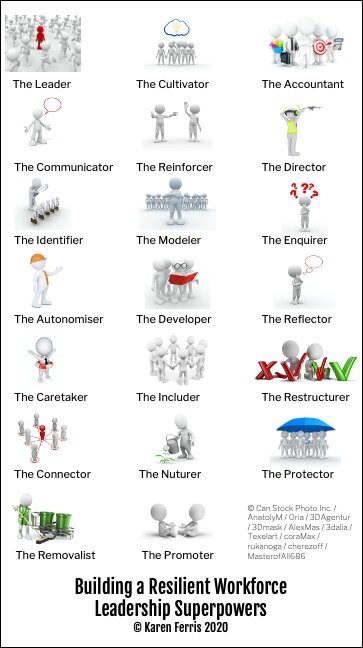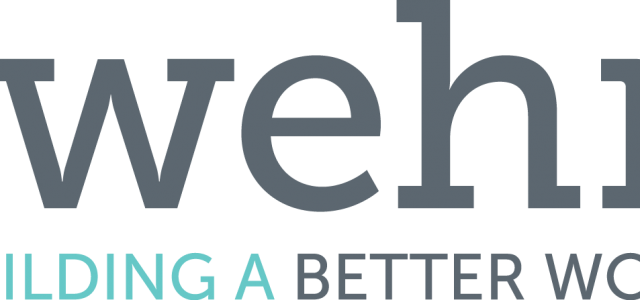This is a blog in the series about leaders creating a resilient workforce in the face of constant change. There is an inordinate amount of research which shows that constant and uncertain change can cause stress and anxiety in the workplace.
We need leaders who can create an environment in which resilience will flourish. We need leaders who can identify the early signs of low resilience and take effective action.
If we don’t, the stress and anxiety can result in depression, fatigue and burnout which can have devastating consequences for individuals, their friends and family, and their colleagues and peers.
Let’s end that now.
Superpowers
In my leadership model for resilience, I have assigned leaders twenty superpowers that should aspire to master over time.
These superpowers are all traits and capabilities that leaders need to create a resilient workforce.
Using these superpowers not only increases resilience but also increases employee engagement, motivation, performance and productivity. There is increased collaboration, creativity, experimentation and innovation. These are all competencies that organisations today need to remain relevant and survive.
The superpowers are illustrated in this model.

I will be exploring each of these superpowers with you over the coming weeks.
Before we take that deep dive, let me give you an overview of each superpower.
THE LEADER
Building, maintaining and sustaining a resilient workforce requires leaders not managers.
Great leaders inspire and then get out of the way.
THE COMMUNICATOR
The Communicator has excellent communication skills. Effective communication builds positive relationships, which promotes resilience at work.
THE IDENTIFIER
The Identifier identifies the signs of low resilience early and takes immediate action. When an individual shows signs of low resilience it is often a mental health issue.
It could be the result of stress, anxiety, fatigue, or other factors.
THE AUTONOMISER
The Autonomiser provides employees with autonomy which is the freedom to do their job their way.
Autonomy gives employees the power to shape their work environment in ways that allow them to perform at their best.
THE CARETAKER
The Caretaker makes sure that there is psychological safety in the workplace. If employees fear punishment or humiliation for speaking up, asking questions, raising concerns or making mistakes, there is fear and low resilience.
THE CONNECTOR
A resilient team is one in which employees have a shared sense of purpose and connectedness.
The Connector creates cultural experiences and means of engagement that allow for better collaboration.
THE REMOVALIST
The Removalist works to remove the stigma of mental health in the workplace.
Stigma can be one of the greatest barriers to psychological health and safety in the workplace, therefore having a direct impact on employee resilience.
THE CULTIVATOR
The Cultivator creates the environment for innovation.
Organisations that cannot innovate to stay ahead of the game will cease to exist.
Employees who do not feel safe to contribute through creativity, experimentation and innovation will have low resilience.
Leaders need to cultivate an environment in which innovation thrives.
THE REINFORCER
The Reinforcer reinforces desired behaviours. Positive reinforcement builds resilience.
The basic tenet of reinforcement theory is that behaviour is shaped and maintained by its consequences. Research through the years has shown that employees that are positively reinforced, work together more efficiently and harmoniously and are more resilient in the process.
THE MODELER
The Modeler models resilience.
Employees look to their leaders to model resilience. They want to see how they deal with the pressure of constant and uncertain change. They want to see how they deal with setbacks, let-downs and failed attempts at success, and still manage to bounce forward.
THE DEVELOPER
The Developer creates a culture of learning. When change is constant and ever-increasing in speed, leaders need to move from programs of training to a continuous learning and development model that repeatedly builds employees skills and provides a broad range of formal training options.
THE INCLUDER
The Includer builds a resilient team by fostering and modelling trust and inclusivity.
The Includer embraces the idea that an inclusive workplace is one in which injury, mental illness, or disability do not present obstacles to a fulfilling life in work.
The Includer builds inclusivity through the creation of teams of diversity.
THE NURTURER
The Nurturer builds a culture of trust and respect. When there is trust and respect, employees are connected. They feel safe to express their feelings knowing that there will be respect and their voice will be heard and valued. They trust their leader to be true to their commitments and that they trust them to do the right thing.
THE PROMOTER
The Promoter promotes self-care.
In our busy, always-on lives, we can often forget to look after ourselves. When we don’t look after ourselves, we can get stressed, anxious, fatigued and maybe even burnout.
Self-care is core to our resilience in a world of constant change
THE ACCOUNTANT
Good leadership requires real accountability.
The Accountant is accountable which means taking personal accountability for the choices they make, and their behaviours and actions.
THE DIRECTOR
The Director provides clear direction both themselves and for their employees. They provide clear direction but not at the expense of employee autonomy.
They enable resilience by providing clear direction and when setbacks occur, they are able to get everyone back on track and working towards shared goals.
THE ENQUIRER
The Enquirer asks questions.
Leaders need to develop skills where they stop telling and lead through questions. This conversation shift helps create an environment where teams feel valued, empowered, and motivated—all key ingredients for team resilience.
THE REFLECTOR
The Reflector provides time for reflection. Reflection looks at what went well, what didn’t go too well, what did we learn, what will we do differently next time and how can we improve our resilience.
THE RESTRUCTURER
The Restructurer uses cognitive restructuring to challenge negative and unhelpful patterns of thought that often occur in times of pressure or difficulty.
Our words can either build or damage our resilience. Using cognitive restructuring practices can change the way leaders and teams think about negative situations.
You might like to read Adaptive Leadership – Diversity, by Karen Ferris, next
Article by channel:
Everything you need to know about Digital Transformation
The best articles, news and events direct to your inbox
Read more articles tagged: Featured, Leadership







